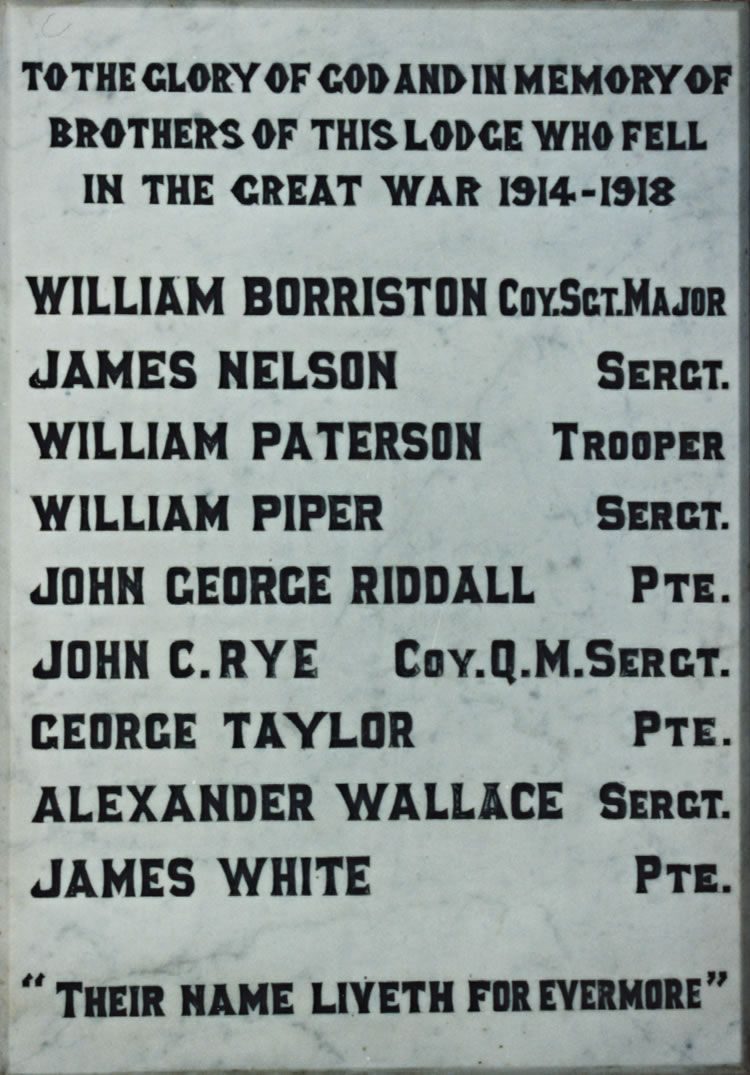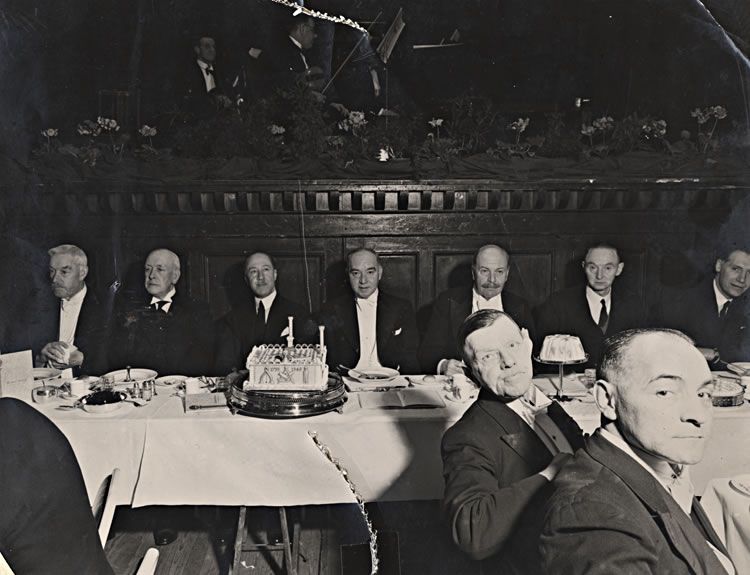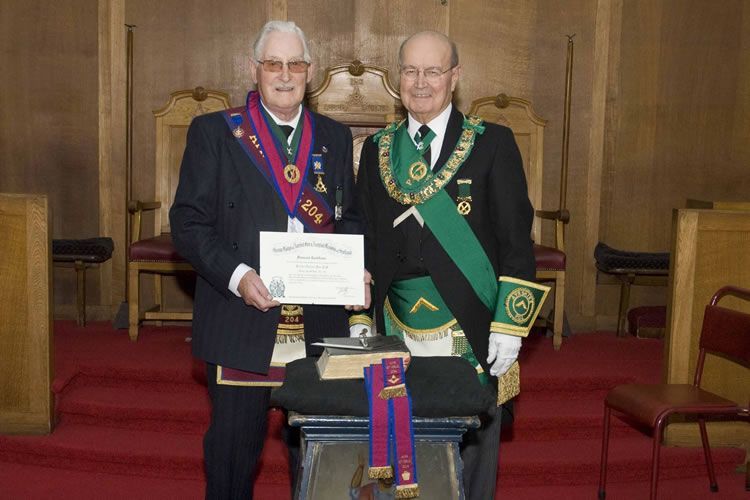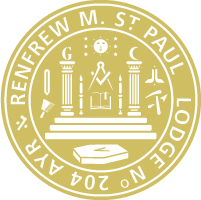History of Lodge Ayr St. Paul 204
Over two hundred years have elapsed since a number of Freemasons serving with the Ayr and Renfrew Militia obtained the necessary authority to form a Lodge within the Regiment, this Lodge was to be known as Ayr and Renfrew Militia St Paul No 271, this Lodge is now better known to us today as Ayr St Paul No 204.
The founding members of the Lodge were serving in the Ayr and Renfrew Militia and due to the troubles prevailing in Europe, and those closer to home, this Regiment found itself more or less on permanent duty. This of course involved frequent moves around the country and due to this the Freemasons within the Regiment found it almost impossible to form ties with any resident Lodges near where they were stationed.
They therefore determined to petition the Grand Lodge of Scotland for a Charter to allow them to hold a Lodge within the Regiment. The Regiment was at this time stationed at Linlithgow, and one of the petitioners went to Edinburgh to plead the petition in person. Grand Lodge granted the petition and a Letter of Constitution was issued dated 4th February 1799, under which the Brethren worked for almost a year.
The first meeting of the Lodge took place at Linlithgow on 6th February 1799 where two brethren (James Brown and Robert Dick), who had previously received the 1st degree at St James Newton-upon-Ayr No 165, now No 125 and Brazen Lodge No 19, now Ancient Brazen No 17 were instructed in the 2nd and 3rd degrees.
In the early part of the following year, the Charter was unceremoniously carried from Edinburgh to Stirling, where the Regiment had been deployed, in a soldier's (John Laughlan) knapsack, neatly folded to fit into the same. The creases made in the Charter when it was in the knapsack can still be seen today.
The Charter bears the same date as the Letter of Constitution, 4th February 1799, and is still in the possession of the Lodge and is on display at all our regular meetings in front of the Master's dais.
A meeting was held in the Guild Hall, Stirling on 13th February 1800 at which the Right Worshipful Master, Wardens and Brethren of Lodges Ancient Lodge Stirling No 31 (now No 30) and Royal Arch Lodge No 93 (now No 76) were present. The purpose of this meeting was to consecrate Lodge Ayr & Renfrew Militia No 271 according to masonic custom, and which according to the minute, was carried out with "every solemnity agreeable to Masonry"
From Stirling the Regiment moved to Fort George, and from there to Inverness and back to Stirling and then onto Glasgow and finally to Ayr in 1802, where, due to the signing of the Treaty of Amiens, the Regiment was disbanded.
Over the next three decades the Lodge partook in several notable public events, they took part in the laying of the foundation stone of the County Buildings and Jail on 23rd April 1818, donating towards the Burns' Monument and taking part in the laying of the foundation stone for the same on 25th January 1820.
The Lodge was at the planting of the Tripod on Burns' Monument on 4th January 1823 and assisted in the laying of the foundation stone of the Ayr Town Hall and Steeple on 28th March 1828. The Lodge also took part in the laying of the foundation stone of the Hall adjacent to Burns' Cottage on 25th January 1847.
On 6th February 1849, the Lodge celebrated its Jubilee. The Lodge at this time, held its meetings in the Vulcan Tavern and the celebration took the form of a supper at which thirty members, including two of the founders attended.
During the next thirty years nothing of much importance happened with the Lodge. Deputations were sent out to assist with the laying of foundation stones at Victoria Bridge, Glasgow on 9th April 1851, the Grand Lodge of Scotland on 24th June 1858 and the Kyle Union Poorhouse 11th October 1858.
In 1854 Bro D Murray Lyon joined the Lodge - a name that many Masons in Scotland and further afield will be familiar with, and who in 1877 was appointed as Grand Secretary, a position he was to hold for twenty-three years.
In 1873 a set of Lodge jewels were purchased from Bro Hay, Grand Jeweller and these jewels are, I believe, still in use by the office bearers of the Lodge today.
In 1894 the Lodge agreed to purchase a vacant plot of ground from the Town Council, situated in Nile Court, just off the High Street as a suitable site to erect a Masonic Hall and in the following year operations got underway.
On 7th February 1896, Bro Sir Charles Dalrymple, Bart., of Newhailes, the Most Worshipful Grand Master Mason of Scotland and other members of Grand Lodge and assisted by the Office-bearers of the Lodge laid the Memorial stone of the New Lodge Room.
On 13th November 1896, a special meeting of the Lodge took place, when the Right Worshipful Provincial Grand Master, Bro Hugh R. Wallace of Cloncaird and Busbie, helped by Provincial Grand Office-bearers consecrated the New Lodge Room according to Masonic tradition.
On 7th February 1899 a supper was given to celebrate 100 years of the Lodge's existence, at which over 140 brethren were present.
In the same year two men were initiated into the Lodge, their names will be instantly recognised by anyone who has indulged in a wee dram or two in the town, they were Matthew Dickie and William Bridges both Spirit Merchants, and pubs in the town still bear their names today.
The early part of the 1900's the lodge was very busy, some years holding as many as sixty-one meetings and having what appears to be an endless supply of candidates, varying from as few as 32 to as many as 146 in a year! They continued with their church parades, visits, social functions, lodge benevolence and when required gave their services at masonic funerals in the town. Ayr St Paul also sponsored the forming of lodge Prestwick 1060 in 1909 and established a friendship that continues to date.
When the Great War commenced in 1914 many brethren were enlisted into the armed services, those that made the ultimate sacrifice are remembered on a memorial stone donated to the Lodge by Bro Col L G Pearson and Bro T W McIntyre in 1921. A Roll of Honour was also produced at that time to honour all those from the lodge who had given service during the War.
Surprisingly there is little or no mention of the war in the minutes, the only thing of note was that a circular was received instructing Lodges that members of "foreign or enemy nationality should not be admitted into the meetings, unless dispensation had been obtained" and the end of the war being noted by the brethren being stood to attention and singing the National Anthem
The memorial stone was in the lodge room at Nile Court, I am unaware if it was removed when we vacated the premises but a photograph of it can be found here. The Roll of Honour can be seen at Fusilier House in Seaforth Road where it is now on display.
February 1926 saw the initiation into the lodge of James Hamilton, a man that was to become highly respected and well known in every Order of Freemasonry throughout Ayrshire and was afforded the title of "Faither of the Lodge" in his later years. He was also honoured by the Grand Lodge of Scotland with the honorary rank of Grand Marshall and the Provincial Grand Lodge of Ayrshire with the honorary rank of Provincial Grand Senior Warden.
The Lodge continued to meet on a regular basis and with the onset of the Second World War the brethren resolved to continue their meetings as normal, although they did decide to change the meeting hour to 7pm "for the duration of the current wartime emergency". The Hall and Basement were also requisitioned for use by the MOD, the Air Observer Corps using the building for the duration of the war.
We continued with social functions and fund raising events, the proceeds going to various funds, Benevolence continued to play an important part of the Lodge's agenda and many grants were made to widows and dependents. The Lodge also gifted to Brethren who were serving with HM Forces the sum of 10 shillings, the equivalent of 50 pence in decimal currency, as a Christmas gift.
In February 1940, the death of Bro William English, Petty Officer, on active service with the Royal Navy is recorded in the minutes, it was also noted that he was one of the youngest Master Masons of the Lodge, and the first from this Lodge to be killed in this conflict. The only other being Bro R M Neil, Flight Lt, RAF, their names being recorded on a Memorial Stone in the old Lodge room.
The Lodge held a Divine and Thanksgiving Service on May 13th 1945 to commemorate Victory in Europe and a Thanksgiving Service for Victory in August the same year marking the end of hostilities.
The lodge celebrated the 150th anniversary of its founding in 1949 at which the Grand Master and dignitaries from the Provincial Grand Lodge were present. The ceremony of re-dedication was carried out in the most solemn manner and the brethren afterwards retired to harmony.
The following year a gentleman by the name of Thomas Main was initiated into the Lodge - he has continued to serve the Lodge for many years, just recently being presented with a diploma to mark his 60th year of membership of the lodge. He has also been honored with grand rank in both the Provincial Grand Lodge of Ayrshire and the Grand Lodge of Scotland and at the ripe age of 87 still continues to take part in the the activities of the lodge. He is currently the oldest attending Past Master of the Lodge. He was the reigning Master on the occasion of the 175th anniversary, which was celebrated with a dinner in the Market Inn.
Founding Members
Master : David McCallum
Depute Master : George Miller
Senior Warden : Andrew Burns
Junior Warden : Fullarton Dick
Secretary : William Fergusson Jnr
Treasurer : Robert Smith
Senior Steward : William Fergusson Snr
Junior Steward : Archibald Currie
Taylor (sic) : Peter Brown
The Charter

The Memorial Stone

The Roll of Honour

James Hamilton

WWII Memorial Stone

150th Anniversary

Bro. Thomas Main

©2023 Lodge Ayr St. Paul 204. All rights reserved. Website powered by CoshNiven


